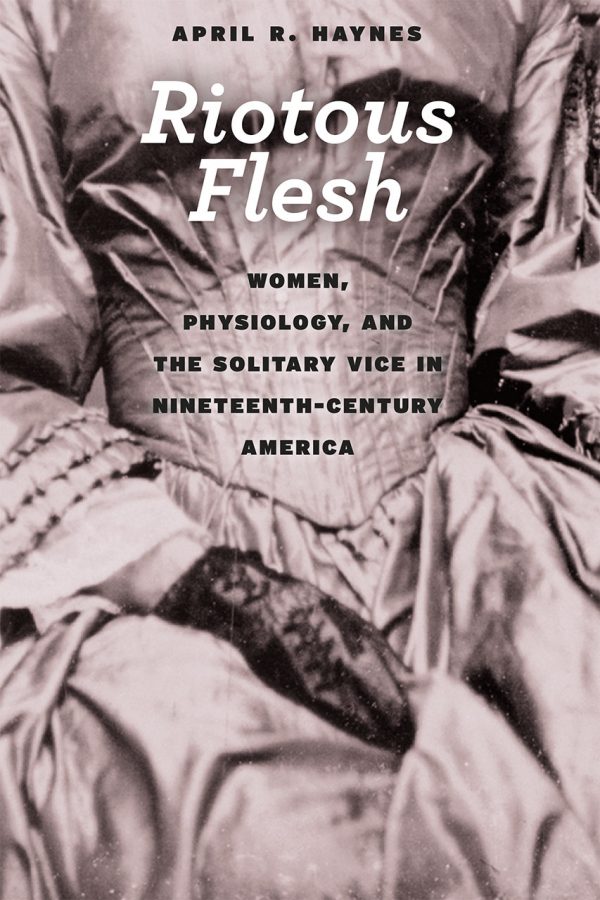Interview by Nicholas Syrett
April R. Haynes’s Riotous Flesh: Women, Physiology, and the Solitary Vice in Nineteenth-Century America (University of Chicago Press, 2015) is a study of antebellum women’s efforts to reform sexuality through public physiology education. One of their ideas, that masturbation caused mental and physical illness, became widely accepted in American popular culture by 1860. Traditionally seen as a movement led by men and targeting male youth, Haynes uses an impressive array of sources to refocus our attention on the racially diverse women who warned girls and women not to masturbate long before male doctors got involved. In so doing they opened up a wide-ranging set of conversations about female sexuality and racial equality. For uncovering, documenting, and analyzing those remarkable conversations, the book won a 2015 James Broussard Best First Book Prize from the Society for Historians of the Early American Republic.

Nicholas L. Syrett: Could you tell us a little bit about how you came to this topic in the first place?
April R. Haynes: As a graduate student, I wanted to study sex radicals during the period most commonly assumed to have seen the height of sexual reticence in the United States. I began by looking at a man named Frederick Hollick, who was prosecuted for obscenity in 1846 for delivering lectures touting female pleasure as natural and healthy to mixed gender audiences. Many of the women who had attended Hollick’s lecture publicly campaigned for his acquittal. They argued that he had done a public service by warning them not to masturbate, a deadly act that caused 90% of all diseases. Their defense of his pro-pleasure lectures caused me to question my own assumptions about dominant ideals of white, middle class female sexuality during the 1840s. At that point, I still wanted to concentrate on sexual outsiders, not female moral reformers. It had not yet occurred to me that moral reformers might once have been the dissenters, because their sexual ideology struck my twenty-first century mind as profoundly conservative.
Then I discovered evidence that some of these women faced riots of men and boys when they tried to attend the physiology lectures of Sylvester Graham, a dietary reformer and namesake of the Graham cracker, in the 1830s. Steve Nissenbaum’s classic book, Sex, Diet, and Debility had thoroughly analyzed Graham’s anti-masturbation rhetoric, and I thought there was nothing left to say about the solitary vice. But the riots made me wonder: if nineteenth-century Americans accepted the idea that masturbation caused debility and death, why would the men in the crowds want to prevent women from hearing that message? And what had changed between 1834 and 1846? What encouraged women in Hollick’s audiences to claim that merely including a warning against masturbation made a lecture respectable? While attempting to answer those questions, I found myself narrating the construction of nineteenth-century masturbation phobia from the perspective of activist women.
NLS: Your first chapter about Sylvester Graham situates those riots as a reaction not so much to the topic of his lectures (masturbation) but rather in the implications they had for male and female sexuality. Can you explain?
ARH: Graham is best known for his Lecture to Young Men on Chastity (1831-1834), which advised male listeners to obey a set of God-given “laws of life and health.” These laws required each individual to restrain their appetites for food and sex. Graham believed that indulgence led to overstimulation, the source of all disease. In making this argument, he challenged a widely shared belief that male bodies required regular sexual “release.” The conventional wisdom held that retained semen was toxic and caused not only disease but also deviant or even dangerous behavior. This “hydraulic model” of male sexuality rationalized men’s sexual privilege, including coercive expectations of sex on demand within marriage. Graham actually thought that his advice against “connubial excess” was the part of the lecture that most outraged his enemies.
But neither the case against masturbation nor the argument for marital restraint provoked a violent backlash until he began conveying both messages to women. Lecture notes from his unpublished “Lecture to Mothers” (1833-1837) show that Graham told female audience members exactly what he had told young men: that all bodies were governed by the same physiological laws. Female bodies were neither less nor more inclined to sexual desire than male bodies, and every individual was capable of governing their own flesh. Newspaper editors called the women’s lecture indecent, and rioters purported to stop Graham from exposing “wives and daughters” to obscenity. But audience members pointed out that the rioters were not their husbands and fathers. Everyone understood that the physiological premise of the lecture—and women’s gathering in public, without male chaperones, for a conversation about sex—challenged the sexual double standard.
NLS: Could you describe the timing of women’s and lay people’s involvement in this reform movement?
ARH: Masturbation phobia in the modern West is generally traced back to the publication of Onania in eighteenth-century London, yet it took another century to reach the level of a dominant discourse in the United States. I argue that this is because “onanism” focused on male bodies, and there was nothing controversial about the idea that men needed to master their own bodies in early America. That ideology served the social order before and after the American Revolution, before and after the rise of market capitalism. It needed no defense and could exist as a kind of quiet background noise that only sporadically made its way into print or the diaries of elite men. What changed was that in the 1830s, women began to use the newly gender-neutral language of “solitary vice” (which did not revolve around spending or saving semen) to publicly assert their own sexual subjectivity. Now that was controversial.
The riots it sparked prompted many who had formerly cared very little about this particular sexual behavior to take it seriously. Moral reformers spread physiological warnings against the solitary vice far beyond urban lecture halls. Some converts marketed therapies that would reverse diseases they attributed to masturbation. Others created educational institutions that they hoped would prevent children from taking up the solitary vice in the first place. All of these writers parsed healthy from unhealthy pleasure, giving rise to a new discourse of normative sexual desire between the 1830s and the 1850s. Before sexologists ever used the word heterosexuality, popular scientists and reformers argued that “opposite” sexes were drawn together magnetically by a natural force called “amativeness.” The solitary vice became a foil for healthy amative sex, which they represented as a social virtue.
NLS: Why is the timing of the anti-masturbation scare significant for our understanding of the medicalization of sexuality more generally?
ARH: I think emphasizing medicalization can keep us focused on before-and-after and acts-versus-identities narratives in which sexology continues to dominate our perceptions of the past. One of the driving questions of my work has been: “Why would people in the past listen to, let alone conform to (or react against), the pronouncements of self-proclaimed experts on sex?” In the United States, doctors had little intellectual credibility before the late nineteenth century. They were only barely beginning to organize as a profession during the 1840s, and they did so amid widespread opposition to any state backing of their authority. They seldom agreed with one another about any theory of disease and they competed with a vast array of self-taught and sectarian practitioners. In this context, patients drove medical discourse by patronizing the healers who reflected their own beliefs about sexual health. Patients’ beliefs were informed by popular physiology lectures, home health manuals, pressure from family members and other intimate contacts, or pornography—and all of these discursive sites were deeply affected by the evangelical discourse against masturbation that women promoted during the 1830s.
NLS: One of the most exciting parts of the book is your recovery of antebellum African American women activists in the realm of sexual politics. Could you tell us a little bit about their involvement in the moral reform movement?
ARH: First, it’s important to acknowledge that publicly discussing sex across the color line was tremendously risky for African American women in a culture that stereotyped them as hypersexual and disproportionately subjected them to sexual violence. So I was surprised to discover that black abolitionist women attended Graham’s Lecture to Mothers, comprising about ten percent of the audience in some cities. Hostile newspaper editors sparked riots by condemning the physiology lectures as sites of amalgamation. Some black abolitionist women also organized female moral reform societies, such as the A.M.E. Zion Female Moral Reform Society in New York City, to bridge the struggle against slavery and white supremacy with the new campaign against the sexual double standard. White moral reformers during the 1830s were theorizing licentiousness as a problem of systemic sexual power (not just individual sexual sin), so black abolitionist women pressed them to carry this impulse to its logical end by fighting against “the licentiousness of slavery.”
NLS: You argue that African American moral reformers made an important distinction between “virtue” and “purity.” What was the nature of that distinction, and how did they use it to reorient the conversation around women’s sexuality in light of racial discrimination, slavery, and sexual exploitation?
ARH: The campaign against the solitary vice implicitly created an opening to challenge racialized stereotypes of womanhood. As some white women voiced their own sexual desires and took responsibility for self-control, African American moral reformers used meetings and newspapers to push the movement toward a new way of thinking about female sexuality. They suggested that rather than working to protect purity—a passive corporeal state associated with whiteness—moral reformers should strive for virtue, a condition of active striving that connoted republican citizenship. The problem with purity was that it could presumably be corrupted. That assumption formed the core of the idea of the “fallen” woman; once she had been seduced, she was forever marked as outside the circle of protected womanhood.
But virtue could not be compromised by another person’s actions. No seducer or assailant—or slaveholder—could rob a woman of her virtue. Black moral reformers were trying to dispense with the virgin/whore binary that pervaded American sexual culture, to their great disadvantage. Unfortunately, white moral reformers of the 1840s tended to be most interested in proving their sexual virtue in highly individualized ways, especially by performing mastery of their own sexual desires. Few engaged in the kind of ongoing political accountability that their black comrades had deemed inherent to true virtue. The moral reform movement fractured and a new generation of white women at the helm turned back toward purity, while anti-masturbation discourse spread outward into more secular domains of popular culture.
NLS: When I teach classes in the history of women or sexuality in the U.S. we read Nancy Cott’s landmark essay, “Passionlessness.” Cott’s goal is to figure out where the idea came from that white middle-class women were seen by others as passionless and believed themselves to be so. My students inevitably ask: “But were they really?” and I answer that we have to assume that in many circumstances, behind closed doors, many were not. But your book provides us with exciting new answers and they’re fully out in the open. Can you tell us about them and why they are so significant?
ARH: When white, middle-class women crusaded against the solitary vice, they testified in meetings and in print that they (or women they knew) had masturbated before learning that it caused disease. This in itself was an admission that they had sexual feelings and that their desire could exist independently of men. They didn’t need to be seduced to feel passion; it came naturally. For evangelicals, this realization came with the imperative to restrain lust whether alone or with a partner. But physiology lectures to women proliferated beyond the moral reform movement during the 1840s. Secular lecturers like Hollick described female orgasm, the importance of the clitoris, and methods for controlling reproduction in great detail—all under the auspices of warning women against the solitary vice.
White, middle-class women were the main consumers of this information. They shaped the sexual messages that circulated in the mid-nineteenth century by consuming lectures, books, and pamphlets that affirmed their right to “amative indulgence” within marriage. This political project, the pursuit of what later sex radicals would call “the erotic rights of woman,” shaped the nascent movements for marriage reform and women’s political rights. It was tremendously empowering for some women, but it also had significant limitations: it perpetuated the racialization of normative feminine desire as white, and it assumed heterosexual marriage was the only appropriate ground on which to assert erotic rights.
Yet while amativeness presaged heteronormativity, I also found that some white, middle-class women went to popular physiology lectures because they simply took pleasure in looking at images of female bodies and discussing sex with other women. Some pursued long relationships that historians used to consider chaste romantic friendships. Rachel Hope Cleves has persuasively challenged that characterization in her recent book, Charity and Sylvia. I think it’s significant that some women who went on to live in what we might now call same-sex marriages met in public lecture halls where they organized in defense of their right to learn and speak about the nitty-gritty details of sexual pleasure. It’s ironic that even they promoted the idea that masturbation was beyond the outer limit of healthy, normal female eroticism.
NLS: As you point out in the introduction, feminists of the 1970s embraced masturbation as a key feature of women’s sexual liberation, reclaiming it from the notion that it drove women mad. While reformers, women and men, had argued that this was so for girls and boys in the nineteenth century, for much of the twentieth century masturbation, whatever its effects, has been seen as a man’s pastime. How was masturbation by girls and women so thoroughly erased?
ARH: When physicians began to pay serious attention to masturbation in the 1840s, they steered the conversation back towards male bodies by importing Claude-François Lallemand’s diagnosis of “spermatorrhea,” which reprised Onania’s focus on seminal loss. By that time, many more Americans were prepared to take the issue seriously than had done so during the eighteenth century. Female moral reformers were also partly responsible for the masculinization of the solitary vice in the middle and late nineteenth century. When their movement fractured in the 1840s, the white leadership distanced themselves from masturbation in order to aggrandize their own moral authority. Rather than cultivating virtuous self-restraint, as had early moral reform women, these moral guardians affirmed the renewed medical focus on young and male masturbators. They argued that adult white women’s maternal “nature” would make them better teachers, missionaries, institutional administrators, and even physicians, than men—and thus better able to police masturbation among the populations most likely to engage in it.
Female masturbation never totally disappeared from early twentieth-century theories of sex. Havelock Ellis and Sigmund Freud both acknowledged its existence and subtly blamed a prior generation of women for instilling European and American youth with neurosis about masturbation. But Freud and his popularizers also insisted that girls must pass through a phase of clitoral masturbation as they matured into “normal” (heterosexual) women. Feminists of the 1970s reacted against that idea because it defined the sexual culture in which they became activists. So the final irony in this story is that two movements, both led by women and committed to the principle of sexual autonomy, took diametrically opposite approaches to the solitary vice.
April R. Haynes is assistant professor of history at the University of Wisconsin-Madison. Her article on Frederick Hollick appeared in the Journal of the History of Sexuality and has been anthologized in American Sexual Histories. She is also the author of “Sex-In’s, College Style: Black Feminism and Sexual Politics in the Student YWCA, 1968-1980,” a chapter in Women’s Activism and “Second Wave” Feminism: Transnational Histories, forthcoming from Bloomsbury in 2017. She is currently writing a book about the relationship between sex work and domestic labor in the early American republic.
is assistant professor of history at the University of Wisconsin-Madison. Her article on Frederick Hollick appeared in the Journal of the History of Sexuality and has been anthologized in American Sexual Histories. She is also the author of “Sex-In’s, College Style: Black Feminism and Sexual Politics in the Student YWCA, 1968-1980,” a chapter in Women’s Activism and “Second Wave” Feminism: Transnational Histories, forthcoming from Bloomsbury in 2017. She is currently writing a book about the relationship between sex work and domestic labor in the early American republic.
 Nicholas L. Syrett is associate professor of history at the University of Northern Colorado and a co-chair of the Committee on LGBT History. He is a co-editor of Age in America: The Colonial Era to the Present and author of The Company He Keeps: A History of White College Fraternities and American Child Bride: A History of Minors and Marriage in the United States. He has also published articles on queer history in American Studies, Genders, GLQ, the Journal of the History of Sexuality, and the Pacific Historical Review.
Nicholas L. Syrett is associate professor of history at the University of Northern Colorado and a co-chair of the Committee on LGBT History. He is a co-editor of Age in America: The Colonial Era to the Present and author of The Company He Keeps: A History of White College Fraternities and American Child Bride: A History of Minors and Marriage in the United States. He has also published articles on queer history in American Studies, Genders, GLQ, the Journal of the History of Sexuality, and the Pacific Historical Review.

NOTCHES: (re)marks on the history of sexuality is licensed under a Creative Commons Attribution-NonCommercial-NoDerivatives 4.0 International License.
Based on a work at www.notchesblog.com.
For permission to publish any NOTCHES post in whole or in part please contact the editors at NotchesBlog@gmail.com




